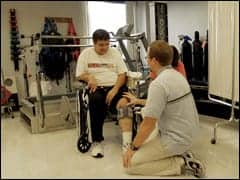 |
| Gait and balance training helps foot drop patients regain function and independence. |
For many able-bodied people, walking to and from the car or to and from the bathroom is a daily activity that takes little thought. After all, studies have shown that a person, on average, will take anywhere from 5,000 to 7,000 steps every day. However, for those with foot drop, taking one step can be difficult—not to mention thousands of steps, which might very well be impossible. At least, it used to be impossible. Thanks to a new state-of-the-art functional electrical stimulation (FES) system with a low-profile design that is worn on the lower leg and foot, enabling easier, more natural walking, patients are beginning to find that a stroll through the park might just become as easy as it sounds.
Before implementing solutions that increase function and independence, we must understand the problem. Foot drop is just that—a nerve or muscle disorder that leaves a person unable to raise and lower his or her foot at the ankle. This disorder makes walking a challenge because the patient cannot control the foot at the ankle. The foot may appear floppy, and the patient may drag the foot and toes while walking.
Foot drop is not a disease. It is not something you develop as a result of your genetic disposition. Instead, the disability usually occurs due to some insult to the brain, such as a stroke. People with back problems, herniated disks, visual problems, and sensory problems are also common sufferers of foot drop. Balance can also become a problem for those who develop a weakness due to illness or inactivity, an inner ear problem, or the aging process. Depending on the cause, this disability may be temporary or permanent.
GOOD BALANCE
Foot drop, much like walking or running, is all about balance. Good balance is the result of adequate range, good strength at the hip and ankle, and healthy visual and vestibular systems. If one of these areas is a problem, the patient overcompensates with improper posture or cannot perform the right reactions when he or she has a loss of balance. The patient’s core of stability, the area in which he or she has to move in all directions before falling, is usually very limited. As a result, those with foot drop are at a high risk of sustaining an injury due to a fall.
Identifying someone with foot drop is often easy. To clear his or her foot, most patients do one of two things. First, the patient might overcompensate with a high-stepping motion. Second, the patient might also swing his or her leg out to the side and raise the hip to clear the distance for the foot.
Like most other disabilities, there are varying degrees of foot drop. It can be identified through muscle strength and sensory testing, gait analysis, and balance testing. Once the problem is identified by a trainer or a professional in the medical field, it becomes easier to attack through a variety of treatments.
One treatment might be surgery, which can correct or alleviate the problem. For example, if foot drop is caused by a herniated disk, disk removal might be an option.
Still, like many other disabilities, rehabilitation is often—if not always—one of the primary treatments. Patients may be fitted with a brace or a splint that fits into the shoe to stabilize the ankle and/or the foot. This type of treatment can mimic the natural ankle motion, thus helping the patient gain increased control of the foot. Ankle-foot braces are generally made from plastic, which supports the ankle. The brace also holds the foot and ankle in the correct position.
But many times, this is not enough. This is where gait training comes into play. There are a host of options, depending on the degree of difficulty patients are having with foot drop: elliptical machines, recumbent bikes, or therapeutic exercisers that use movement therapy to help the patient increase muscle strength and endurance.
STATE-OF-THE-ART REHAB
In late 2006, patients with foot drop learned about a new device that many rehabilitation specialists believe could change the way this disability is viewed and treated.
The device is a state-of-the-art FES system that enables easier, more natural walking as well as a return to a more normal lifestyle. The product of a Santa Clarita, Calif-based company that has pioneered the use of exoskeletal and implantable bionic technologies, the unit also facilitates a more fluid gait and stimulates muscle re-education while helping to prevent/retard disuse atrophy, maintain and increase joint range of motion, and increase blood flow. It is designed to help patients with life-altering neurological disorders that affect their lower extremities, such as stroke, traumatic brain injury, multiple sclerosis, and cerebral palsy; and it recently received approval from the FDA. The company and the FDA selected one inpatient beta site—Good Shepherd Rehabilitation Network, Allentown, Pa—and one outpatient site in Milwaukee to test this new product and provide patient and therapist feedback prior to its launch.
HOW IT WORKS
Here is how it works: When an individual walks, he or she alternately swings his or her legs forward. The unit enables patients with foot drop to complete this motion just as an able-bodied person would. It features a gait sensor, which provides real-time adaptive gait recognition. Patients can seamlessly transition between varying terrains, different walking speeds, and more appropriate rhythms and styles. This feature enables the user to walk with greater confidence and ease, leading to an increase in mobility and independence.
|
Search our website for more information on gait and balance training. |
|
The device has two small parts. Each part is no bigger than a modern-day Walkman, which means it is lightweight. Patients wear a wireless device that wraps around their heel and ankle. This device sends real-time information to a second device that is wrapped around the knee. The gait sensor around the ankle detects “heel on” and “heel off” positions, and it signals the stimulator to initiate or pause accordingly.
The FES unit was shown to effectively increase gait speed, stability, and symmetry in gait clients with foot drop. This device facilitates voluntary movement, improves blood circulation, and may prevent atrophy. In addition, it helps maintain or increase joint range of motion—thanks to the renewed flexibility of the ankle joint and foot.
Good Shepherd has been testing patients in its inpatient rehabilitation hospital, and it recently began to use the device in its outpatient neurorehabilitation facility. In the long term, rehabilitation specialists hope patients will be able to use this device in every facet of their lives. During this testing phase, Good Shepherd wants to answer the following questions:
- Is the device working properly?
- Can the therapists easily integrate the L300 into the inpatient and outpatient treatment process?
- How will the therapists use the device during treatment?
Technologies have certainly changed over time. It is much easier to show measured progress than ever before. Like with most other disabilities, evolving rehabilitation technology is an adjunct that more quickly helps patients regain function and independence.
Susan Golden, PT, is the regional manager of Good Shepherd Rehabilitation Network, Allentown, Pa. For more information, contact .





